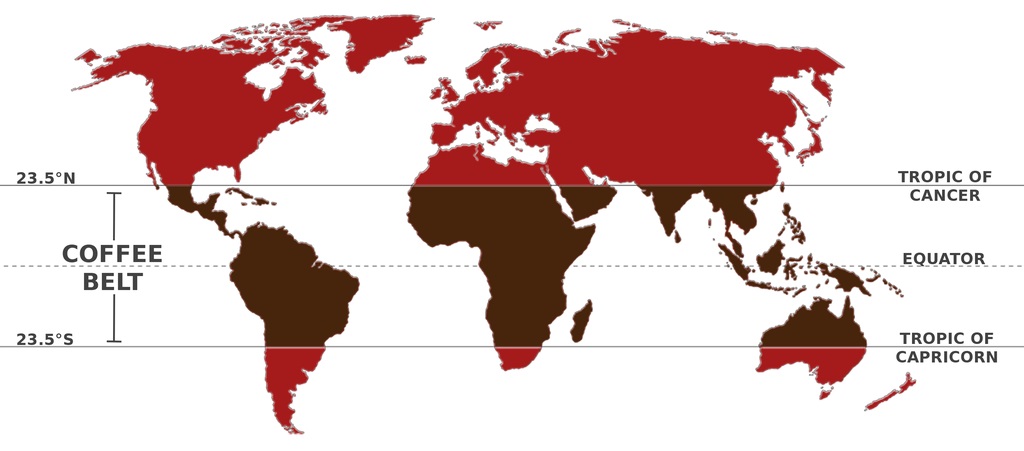From west to east, the major coffee producing regions fall into a band around the equator, an imaginary line named The Coffee Belt. Between the tropic of Cancer and the tropic of Capricorn wrapping from Africa to Asia, these countries provides most of the coffee we drink every day.

Stable temperatures, moderate precipitation and rich soil make the perfect conditions for coffee trees. Back in the 14th century wild seedlings of coffee were exported from Ethiopia to Arabian Peninsula, and by the end of the 17th century coffee beans had spread as far as Java and Sumatra. Then, the coffee culture entered the New World countries, and took roots in Brazil, Guatemala, Costa-Rica, Jamaica and Cuba. By the beginning of the 19th century the circle closed and our planet got the “coffee belt”, within which all the main coffee plantations are located.
| Continent | Countries |
| CENTRAL AMERICA | Costa Rica, Guatemala, Honduras, Mexico, Nicaragua, Panama, El Salvador |
| SOUTH AMERICA | Bolivia, Brazil, Colombia, Ecuador, Peru |
| AFRICA AND ARABIA | Burundi, Congo, Ethiopia, Kenya, Rwanda, Tanzania, Uganda, Yemen, Zambia, Zimbabwe |
| ASIA | Indonesia, India, Myanmar, Vietnam, Papua New Guinea |
| ISLANDS AND OTHERS | Australia, Dominican Republic, Hawaii, Jamaica, Puerto Rico |
Every continent that any given coffee is grown in has a remarkable effect of the coffee’s flavor. The variety of the plant, the chemistry of the soil, the weather, the amount of rainfall and sunshine, and even the precise altitude at which the coffee grows can affect the taste of the final product.

And now, covering more than 50 countries, here are the list of countries with major coffee producing in 2017, according to International Coffee Organization that may help you explore the many flavors and tasting notes peculiar to each region. Most people find they tend to favor one particular source of coffee bean, explore nearby regions and discover new varieties and flavors.
1. Brazil (2,594,100 tons)
Notable Beans: Bahia, Bourbon Santos
2. Vietnam (1,650,000 tons)
Notable Beans: Robusta
3. Colombia (810,000 tons)
Notable Beans: Medellin, Supremo, Bogotá
4. Indonesia (739,020 tons)
Notable Beans: Java, Sumatra, Sulawesi (Celebes)
5. Ethiopia (384,000 tons)
Notable Beans: Harrar, Sidamo, Yirgacheffe
6. India (349.980 tons)
Notable Beans: Mysore, Monsooned Malabar
7. Honduras (345,000 tons)
Notable beans : Bourbon, Caturra, Catuai, Typica
8. Uganda (285,300 tons)
Notable Bean: Bugisu
9. Mexico (234,000 tons)
Notable Beans: Altura, Liquidambar MS, Pluma Coixtepec
Source : travelerscoffee.ru, cornerofthecafe.com, ncausa.org, ico.org



















